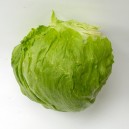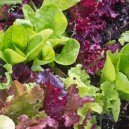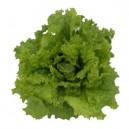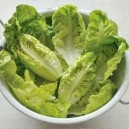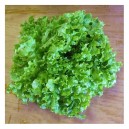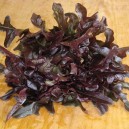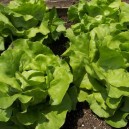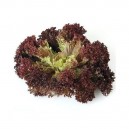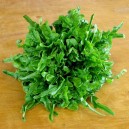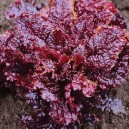
Welcome, Log in
Product Categories
-
Heirloom & OP Seed
- Cool Weather Crops
- Warm Weather Crops
- Beans
- Beetroot
- Brassicas
- Carrots
- Chard
- Corn/Maize
- Cucumbers
- Eggplant (Aubergine)
- Leeks
- Lettuce
- Melons
- Okra
- Onions
- Parsnips
- Peas
- Peppers & Chillies
- Radish
- Spinach
- Squash & Pumpkins
- Tomatoes
- Turnips
- Unusual / Exotic
- Herbs & Spices
- Fruits & Berries
- Value Packs
- View All Seed
- Gift Vouchers
LettuceThere are 10 products.
Please scroll down or click here to view the product list
GROWING INSTRUCTIONS FOR LETTUCE
Binomial Name: Lactuca sativa
Varieties: Buttercrunch, Green Oakleaf, Green Salad Bowl, Cinnamon Cos, Butter Blush, Lollo Rosso, Forellenschluss, Brune D'Hiver, Henderson's Black Seeded Simpson, Little Gem, May Queen, Mervielle des Quatre Saisons, Tom Thumb, Parris Island Cos, Mignonette Bronze
Start: Seeds or seedlings
Germination: 7 to 14 days, 5°C to 30°C
Seed Life (viability): 3-4 years
Soil: Well drained
Sunlight: Full sun, part shade
Sow Seeds: 1 cm apart
Transplant/Thin to: 15 - 25 cm apart
Ave. Days to Harvest: 25 to 75
Good Companions: Asparagus, Beans, Beetroot, Cabbages, Carrots, Celery, Chicory, Cucumber, Dill, Fennel, Kohlrabi, Leeks, Mint, Onions, Peas, Pumpkins, Radish, Rhubarb, Strawberry, Sweetcorn, Tomatoes, Yarrow
Bad Companions: Parsley, Parsnip
Sowing & Planting: Lettuce is adaptable to many growing conditions, but likes it cool - around 15 C to 18 C. Generally, better results will be obtained by growing during the cooler months. Lettuce grows best in full sun, though excessive heat can cause plants to bolt to seed, or leaves to wilt.
Tip: South African full sun, especially during summer, is generally too hot for lettuce production and they should be grown under shade - 30 to 40% shade cloth would be ideal. Also, if growing during hot summer conditions, be sure to keep the top few centimeters of soil moist at all times (a good mulch helps). Lettuces are very shallow rooted plants and even a few hours of a lack of water will send the plants into survival mode (i.e. they will bolt / go to seed).
For an early start, seeds can be started in seed trays 4 weeks prior to the last frost and transplanted outdoors in mid to late spring.
Lettuce is tolerant of a wide range of soils, but prefers well-drained, cool, loose soil with plentiful moisture and pH 6.2 to 6.8. To encourage tender and tasty growth, make sure location is rich in organic compost matter. Amend prior to planting if needed.
Direct seed or transplant in early spring, as soon as you can work the soil. Prepare beds by working in manure or compost and raking smooth to leave a fine seedbed. Seeds need light to germinate; sow at a very shallow depth by covering with a thin layer of growing medium.
Direct-seeding: Sow seed 2-3mm deep, 2.5cm apart in rows 30 to 45cm apart. When plants have two or three true leaves, thin to 30cm spacings for crisphead varieties, 15 to 25cm for other types. You can also lightly broadcast seed (particularly of looseleaf varieties) in a patch instead of a row.
Transplants: Sow in seed trays 3 to 4 weeks before transplanting outside. Harden seedlings for 3-5 days before transplanting.
Growing: Use row covers or cloches to protect very early plantings from cold, to protect young plants from insects and (supported by hoops) to shade crops when warm weather arrives.
Make succession plantings every week or two, and grow several varieties with different maturity dates for a continuous supply. Moisture, stress, and high temperatures, particularly at night, encourage bolting. As the season progresses, plant more bolt-resistant varieties. Locate plants where they will be partially shaded by taller nearby plants, latticework or other screen.
Mulch to retain moisture and to suppress weeds. Fertilizing can be helpful to promote faster growth, especially a fish emulsion type that is not high in nitrogen that can cause greens to become bitter. Water lightly but consistently.
Harvesting: Many varieties of lettuce can be harvested as microgreens, baby greens, leaves, or the entire plant. Ideally, greens should be collected early in the day, before the onset of midday sun, to prevent wilting.
Microgreens are usually harvested within 2 weeks after germination by cutting the entire plant just above the ground, once it is around 10cm tall.
Baby greens are harvested between 28 and 35 days after germination. Looseleaf, butterhead and romaine types can typically be harvested as baby greens, while iceberg lettuce is not suitable as baby greens.
Mature leaves can be harvested from all types of lettuce, except for iceberg, any time in the growing cycle, until a central stem begins to form. This indicates that the plant is preparing to bolt to seed and greens collected from such plants are often too bitter for consumption.
Entire plants can be harvested in mid-development while the leaves are still plump and tender, but before a stem has started to form. Many varieties of looseleaf lettuce can be harvested numerous times during a single growing season.
Some other general guidelines when harvesting the entire plant: Leaf lettuce can be cut as soon as it is large enough to use, usually in 50 to 60 days from planting. Cutting every other plant at the ground will give remaining plants more space for growth.
Romaine and Butterhead lettuce can be harvested in about 60 to 70 days from planting.
Iceberg (crisphead) varieties take longer and should be harvested as soon as a head develops but before outer leaves turn brown. If seed stalks appear, pick the lettuce immediately and store in the refrigerator to prevent bitterness.
To store lettuce, first wash it well by immersing in water and swishing it around. Place it in a colander and rinse then drip dry. When it is dry, place it in a plastic bag in the refrigerator or wrap in paper towels and place in a bowl in the refrigerator. Avoid storing lettuce with apples, pears or bananas as they release a natural ripening agent that will cause brown spots and the leaves will decay quickly.
-
R 25.00Add to cart More Details
Available -
R 25.00Add to cart More Details
Available -
R 25.00Add to cart More Details
Available -
R 25.00Out of Stock More Details
Coming Soon -
R 25.00Add to cart More Details
Available -
R 25.00Add to cart More Details
Available -
R 25.00Out of Stock More Details
Coming Soon -
R 25.00Add to cart More Details
Available -
R 25.00Out of Stock More Details
Coming Soon -
R 25.00Out of Stock More Details
Coming Soon
